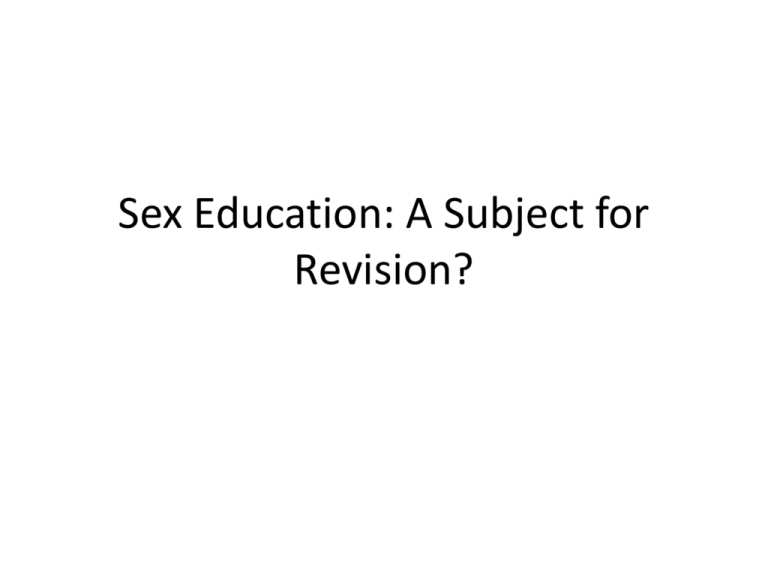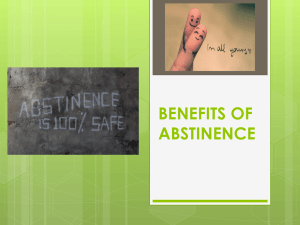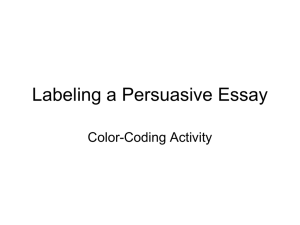
Sex Education: A Subject for
Revision?
Thirteen percent of teens have had vaginal intercourse by the age of fifteen while sexual activity is common in the late teen
years (Abma, 2010). Out of these sexually active teens, there are approximately 750,000 pregnancies reported. The
Guttmacher Institute (2010) reports 82% of these pregnancies are unintended, 59% end in birth, and more than one quarter
end in abortion. These pregnancy rates are amongst the highest in developed countries (McKay, 1996-2006). Even more
alarming, roughly 19 million new STDs occur each year among teens with Gonorrhea and Chlamydia being extremely high
(Weinstock, 2000). While the media has seized the opportunity to glamorize teen pregnancy, we as a community need to
become proactive in prevention. How can teen pregnancy be prevented some might ask? The answer is simple however the
solution is controversial –education. The controversy happens with how the topic of sex is taught. Religious groups and
leaders teach abstinence only, while the health community would prefer comprehensive sex education. In the middle of all
this controversy are America’s teens
Abstinence Only
Religious leaders, parents and educators with strong beliefs of abstinence only programs define abstinence as delaying sex until marriage.
Although to adults this may seem to be direct and concise, it’s open to interpretation for teens. From a teens perspective abstinence can
be defined in terms such as postponing sex, never having vaginal intercourse, or refraining from sexual intercourse if sexually
experienced. Abstinence is defined by how one behaves according to this terminology. The goal of abstinence only programs is to
promote a healthy lifestyle for teens by instilling moral values into them. Teaching adolescents that abstinence is the expected standard
for all school aged children and is the only way to avoid out-of-wedlock pregnancy and STDs is a great message. Most if not all people can
agree on this most important fact in the curriculum. However, with this alone the definition of abstinence is left up to the individual
student for interpretation. With so much diversity among our population, no teacher can believe that every student will believe in the
moral guidelines set forth with abstinence only education. Since abstinence is viewed by teens as “good behavior” teachers must find
and employ a plan for the so called “rebels.” What form of outreach is available for those teens that believe touching, kissing, mutual
masturbation, oral sex, and anal sex is within the guidelines of abstinence? Adolescents may still consider themselves as “virgins” as long
as coitus does not occur. Abstinence does not clearly classify the other sexual encounters, leaving adolescents with only a small
spectrum of information. There is not much evidence available to prove abstinence only education is the best possible solution.
According to a study done by the Archives of Pediatric and Adolescent Medicine, theory based abstinence-only interventions “may” have
an important role in preventing adolescent sexual involvement (2010).
Comprehensive Sex Education
Comprehensive sex education does not have any specific definition in use. One can gather from the definition of
comprehensive that all information will be complete, including all aspect of sexual behavior and/or morals.
Although abstinence until marriage is the goal, few American’s wait until marriage to initiate intercourse. With
that being said adolescents need to be equipped with as much knowledge as possible to aid them in making the
best lifestyle decisions. Data indicates the median age at first intercourse for women is 17.4 years, whereas the
median age at first marriage is 25.3 years (Fields, 2004). For men the corresponding median age at first
intercourse is 17.7 years, whereas the age at first marriage is 27.1 years (Fields, 2004). There is almost a decade
of sexual activity between adolescence and marriage. During this time if no formal education is given about
healthy relationships, protected sex, human anatomy, psychological effects and other factors that coincide with
sexual activity, adolescents will become unknowledgeable adults. On the other hand, if during
“comprehensive” sex education students are merely handed out condoms, this will also lead to misguided
adults. Comprehensive sex education needs to be age and maturity level appropriate. In order for the
education to truly be comprehensive, it needs to be a continued course from junior high school until high
school is completed. Margaret J. Blythe, a medical doctor on behalf of the American Association of Pediatrics
testified this to the US government:
Can Abstinence-Only and Comprehensive Education be combined?
There is much debate over which method of teaching sex education is best. What is in
everyone’s best interest? The best interest is a settlement on what is better for all
students. Just as students have standards for subject matter such as Math, English, and
Science, a standard of abstinence should as well be expected. Families, teachers, and
community leaders do not crucify students who fall below educational standards. Therefore,
abstinence should be held with the same regard. The new focus of sex education should a
holistic approach, teaching students about the mind, body, and soul connections associated
with sexual activity. If students are educated about the risks taken each time they choose to
engage in sex, perhaps they will choose to stay or become abstinent. The curriculum needs to
be totally reformed. First, standard expectations should be established i.e. all sexual activity
is expected to be withheld until marriage. Secondly, understand that not every student will
comply with the standard expectation. For those who will not comply, do not publicly
demean them instead educate them on the consequences of every action taken. Thirdly,
employ programs to reach students who are engaging or at risk for engaging in risky
behaviors such as unprotected sex, multiple sex partners, and planned pregnancy. Most
importantly teens need to know that there are consequences with every action taken, good,
bad, or indifferent. There are consequences associated with abstinence as well as with sexual
activity. Some of these consequences may include loss of friendships, or public ridicule. In
2008, Advocates for youth published Science and Success which confirms comprehensive sex
education in schools reduced teen pregnancy, delayed initiation of sex, reduced the
incidences of STI’s, and increased the use of contraception and condoms among sexually
active teens.
“Children and adolescents need accurate and comprehensive education about
sexuality to practice healthy sexual behaviors as adults, but also to avoid early,
exploitative
or risky sexual activity that may lead to health and social problems, such as unintended
pregnancy and STIs, including HIV infection and AIDS. This is especially true among
gay, lesbian and bisexual youth who are more likely to have had sexual intercourse, to
have
had more partners, and to have experienced sexual intercourse against their will,
putting
them at increased risk of STIs including HIV infection. The data is clear that abstinence
is the most effective means of birth control and prevention of STIs and needs to be
included as part of an individual’s strategy to reduce unintended pregnancy and STI
rates.
But abstinence should not be taught as the only strategy. To date, the evidence
regarding
the efficacy of abstinence-only in the reduction of risky sexual behaviors, including risk
for
STIs, has not been proven” (2008).








